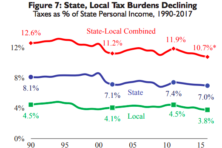Ten Key Questions for Candidates: Part One
- Share
- Tweet
- Pin
- Share
by The Wisconsin Taxpayer, The Wisconsin Policy Forum
On Nov. 6, voters will select Wisconsin’s governor, all 99 members of the state Assembly, and 17 of the 33 members of the state Senate. When they take office in January, they will face pressing issues ranging from a looming worker shortage to pressures on state, local and school finances. Drawing on our recent research, we provide a guide to these topics to help voters make informed decisions.
To help voters sort through the noise, we have identified 10 questions that candidates should be addressing regarding six key issues facing the state: transportation, economy and workforce, education, state-local relations, taxes, and Wisconsin’s fiscal health.
These questions emanate from recent research conducted by the Wisconsin Policy Forum on these topics.

To help inform the discussion, we provide background data from our research. Some of these issues may seem complex, but they have important consequences, whether it is the condition of the streets and highways on which Wisconsin residents drive or the condition of the state’s finances.
TRANSPORTATION
Like many other states, Wisconsin faces challenges in funding its transportation programs, such as highway construction and local road repairs.
State funding for these programs comes mainly from the fuel (gas) tax and vehicle registration fees, both of which have been relatively stagnant in recent years.
The state’s $75 annual registration fee for most vehicles has not been raised since 2008, except for an increase for electric and hybrid vehicles in the 2017-19 state budget.
Similarly, Wisconsin’s 30.9 cents per gallon gas tax has not risen since 2006, when automatic increases, known as indexing, were eliminated.
Figure 1 shows the growth of these two revenue sources, which many argue has not kept pace with transportation needs.
In recent years, the state has also relied on borrowing backed by both revenues from the transportation fund (mainly vehicle registrations and gas taxes) as well as general revenues, to fund transportation projects.
Total transportation borrowing peaked at $1.3 billion in 2009-11 before dropping to $402.4 million in 2017-19. Debt service as a share of transportation fund revenues has grown from 10.3 percent in 2006-07 to a projected 20.9 percent in 2018-19.
Spending for transportation areas such as state highway improvements, local road aids, and long-term major state projects (known as “the majors”) has shifted from budget to budget.
As shown in Figure 2, local road aids rose to $455.9 million in 2011, dropped, and then rose slowly. They increased by more than $90 million in the 2017-19 budget. This resulted in less cash available for some state highway improvements and major projects.
Several recent studies have warned that Wisconsin’s current financing system is insufficient to address future needed transportation investments.
A 2016 Department of Transportation solvency study found that under scenarios varying from spending less than the 2015-17 budget to providing modest annual increases, funding shortfalls over the next 10 years ranged from $852 million to $7.9 billion.
Lawmakers have offered proposals to raise transportation revenues, but no action has been taken. Some officials, including the current state transportation secretary, contend the state does not need additional revenues but should instead increase efficiency and reduce the number of projects “in the pipeline” for completion at any given time.
Against this backdrop of uncertain state aid as well as state-imposed limits on property tax increases, a growing number of local governments have adopted vehicle registration fees (also known as wheel taxes) to fund road maintenance and other transportation programs. While the state has allowed local governments to adopt these fees for years, their expanded use has prompted some lawmakers to propose limits on them.
Questions for candidates:
1) Wisconsin relies heavily on gas taxes and registration fees to fund transportation. With revenues from both sources growing slowly, what changes, if any, would you support to meet the state’s transportation needs? If you would not increase revenues, how would you reduce spending in order to adapt to more modest revenue growth?
2) A growing number of local governments have turned to “wheel taxes” to fund their transportation programs. Do you support their ability to do so, or do you favor restrictions on these fees? Would you favor alternative local revenue options instead of, or in addition to, wheel taxes, such as local gas or sales taxes?
Next week, the economy and workforce issues.

